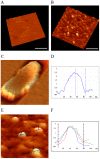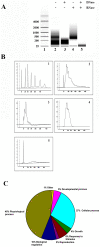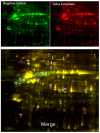Nanostructural and transcriptomic analyses of human saliva derived exosomes
- PMID: 20052414
- PMCID: PMC2797607
- DOI: 10.1371/journal.pone.0008577
Nanostructural and transcriptomic analyses of human saliva derived exosomes
Abstract
Background: Exosomes, derived from endocytic membrane vesicles are thought to participate in cell-cell communication and protein and RNA delivery. They are ubiquitous in most body fluids (breast milk, saliva, blood, urine, malignant ascites, amniotic, bronchoalveolar lavage, and synovial fluids). In particular, exosomes secreted in human saliva contain proteins and nucleic acids that could be exploited for diagnostic purposes. To investigate this potential use, we isolated exosomes from human saliva and characterized their structural and transcriptome contents.
Methodology: Exosomes were purified by differential ultracentrifugation and identified by immunoelectron microscopy (EM), flow cytometry, and Western blot with CD63 and Alix antibodies. We then described the morphology, shape, size distribution, and density using atomic force microscopy (AFM). Microarray analysis revealed that 509 mRNA core transcripts are relatively stable and present in the exosomes. Exosomal mRNA stability was determined by detergent lysis with RNase A treatment. In vitro, fluorescently labeled saliva exosomes could communicate with human keratinocytes, transferring their genetic information to human oral keratinocytes to alter gene expression at a new location.
Conclusion: Our findings are consistent with the hypothesis that exosomes shuttle RNA between cells and that the RNAs present in the exosomes may be a possible resource for disease diagnostics.
Conflict of interest statement
Figures







Similar articles
-
Human saliva, plasma and breast milk exosomes contain RNA: uptake by macrophages.J Transl Med. 2011 Jan 14;9:9. doi: 10.1186/1479-5876-9-9. J Transl Med. 2011. PMID: 21235781 Free PMC article.
-
RNA-containing exosomes in human nasal secretions.Am J Rhinol Allergy. 2011 Mar-Apr;25(2):89-93. doi: 10.2500/ajra.2011.25.3573. Epub 2010 Dec 17. Am J Rhinol Allergy. 2011. PMID: 21172122
-
Body fluid derived exosomes as a novel template for clinical diagnostics.J Transl Med. 2011 Jun 8;9:86. doi: 10.1186/1479-5876-9-86. J Transl Med. 2011. PMID: 21651777 Free PMC article.
-
Exosomes: proteomic insights and diagnostic potential.Expert Rev Proteomics. 2009 Jun;6(3):267-83. doi: 10.1586/epr.09.17. Expert Rev Proteomics. 2009. PMID: 19489699 Review.
-
Ascent of atomic force microscopy as a nanoanalytical tool for exosomes and other extracellular vesicles.Nanotechnology. 2018 Apr 3;29(13):132001. doi: 10.1088/1361-6528/aaab06. Nanotechnology. 2018. PMID: 29376505 Review.
Cited by
-
Detection of exosomal biomarker by electric field-induced release and measurement (EFIRM).J Vis Exp. 2015 Jan 23;(95):52439. doi: 10.3791/52439. J Vis Exp. 2015. PMID: 25650727 Free PMC article.
-
Role of pancreatic cancer-derived exosomes in salivary biomarker development.J Biol Chem. 2013 Sep 13;288(37):26888-97. doi: 10.1074/jbc.M113.452458. Epub 2013 Jul 23. J Biol Chem. 2013. PMID: 23880764 Free PMC article.
-
MicroRNAs: molecular features and role in cancer.Front Biosci (Landmark Ed). 2012 Jun 1;17(7):2508-40. doi: 10.2741/4068. Front Biosci (Landmark Ed). 2012. PMID: 22652795 Free PMC article. Review.
-
Biodistribution and Pharmacokinectics of Liposomes and Exosomes in a Mouse Model of Sepsis.Pharmaceutics. 2021 Mar 22;13(3):427. doi: 10.3390/pharmaceutics13030427. Pharmaceutics. 2021. PMID: 33809966 Free PMC article.
-
Biological properties of extracellular vesicles and their physiological functions.J Extracell Vesicles. 2015 May 14;4:27066. doi: 10.3402/jev.v4.27066. eCollection 2015. J Extracell Vesicles. 2015. PMID: 25979354 Free PMC article.
References
-
- Delcayre A, Estelles A, Sperinde J, Roulon T, Paz P, et al. Exosome Display technology: applications to the development of new diagnostics and therapeutics. Blood Cells Mol Dis. 2005;35:158–168. - PubMed
-
- Heijnen HF, Schiel AE, Fijnheer R, Geuze HJ, Sixma JJ. Activated platelets release two types of membrane vesicles: microvesicles by surface shedding and exosomes derived from exocytosis of multivesicular bodies and alpha-granules. Blood. 1999;94:3791–3799. - PubMed
-
- Rozmyslowicz T, Majka M, Kijowski J, Murphy SL, Conover DO, et al. Platelet- and megakaryocyte-derived microparticles transfer CXCR4 receptor to CXCR4-null cells and make them susceptible to infection by X4-HIV. AIDS. 2003;17:33–42. - PubMed
-
- Blanchard N, Lankar D, Faure F, Regnault A, Dumont C, et al. TCR activation of human T cells induces the production of exosomes bearing the TCR/CD3/zeta complex. J Immunol. 2002;168:3235–3241. - PubMed
Publication types
MeSH terms
Grants and funding
LinkOut - more resources
Full Text Sources
Other Literature Sources
Miscellaneous

